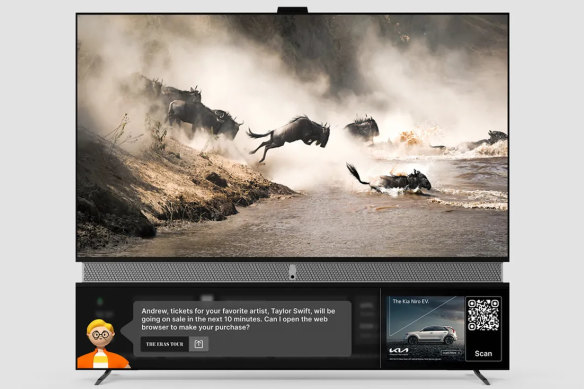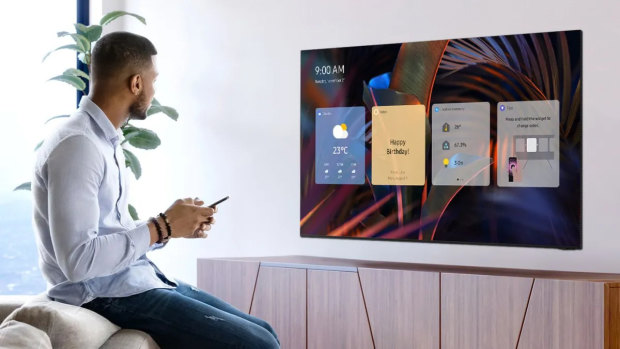ee-through panels and in-home billboards: the future of TVs
The TV as a smart hub
Ever since TVs have been able to connect to the internet, they’ve been on a path to become the centre of our smart homes. Some important hurdles still exist (like how to balance data and notifications with a distraction-free home cinema experience), but the TV is a big screen and always-available computer that most people are already familiar with and may prefer, rather than buy the additional gadgets normally needed to control smart devices.
Samsung has already begun including Matter controllers and Thread border routers in its TVs, which is good because people shouldn’t really need to worry about what those are, or if they have them (they’re used to direct Wi-Fi traffic to smart devices, and typically come in new smart speakers). And at CES, the company introduced a new screen called Now Plus, which will turn TVs into legitimate smart displays.
Your smartphone is a fine gadget for controlling a smart home, but many new devices need help from gear that stays in the house, like a TV.
Now Plus appears on-screen when you stand near the TV, so you don’t need the remote to activate it, and it will show information from your devices such as temperatures, video feeds or current activities. The TVs also have a new quick panel you can summon to do things like turn lights on and off or lock your doors.
Also at CES, Google announced that LG TVs and certain models equipped with Google TV will in future have Matter controllers on board. This will let them do the same job as a Nest smart speaker or display when it comes to managing your smart home devices. The company said that the LG TVs specifically will be able to view and control all devices compatible with Google Home or LG ThinQ in one spot.
Loading
For some households, a dedicated smart-home controlling device will continue to make more sense. But for everyone else (including those who currently have no interest in smart homes), a TV is an obvious household item to do the job.
The in-home billboard
A more dystopian take on the future integration of TV and AI comes by way of US company Telly, which was at CES spruiking new features powered by ChatGPT.
Telly, which began shipping TVs to customers in the US last year, has a unique sales pitch: its 55-inch 4K TV can be ordered free of charge. The catch is, it’s designed to hoover up as much personal data as it possibly can from microphones, cameras and your viewing habits to sell for advertising, with ads also showing up on an integrated smart display underneath the main screen. Users have to agree to a range of data collection to use the TV, and ads can be displayed on both screens when the TV is not in use.
At CES, Telly announced a range of updates that will likely be far more exciting to advertisers than to viewers, including a web browser that makes ads “actionable” directly on the TV, so-called T-commerce capabilities so the TV can charge you for purchases, and QR codes that advertisers can show on the secondary screen. But by leveraging ChatGPT, the TV will also be able to talk to (and upsell) viewers directly.

I know you’re trying to watch a wildebeest documentary, but would you like to buy concert tickets or book a test drive?
The “Hey Telly” assistant will be able to recognise each household member and use different avatars to interact with them, learning their preferences and schedules. In an example shown at CES, an avatar pops up during a show noting that it’s almost time for dinner, and offering to order the viewer’s favourite meal from Uber Eats with the touch of a button.
So are free devices the future of home viewing? The value equation is clearly slanted towards Telly and advertisers (consumers get a TV generously valued at $1000 for free, while the operators get extraordinarily beneficial data), which unfortunately makes its normalisation seem quite likely.
Get news and reviews on technology, gadgets and gaming in our Technology newsletter every Friday. Sign up here.
The TV as a smart hub
Ever since TVs have been able to connect to the internet, they’ve been on a path to become the centre of our smart homes. Some important hurdles still exist (like how to balance data and notifications with a distraction-free home cinema experience), but the TV is a big screen and always-available computer that most people are already familiar with and may prefer, rather than buy the additional gadgets normally needed to control smart devices.
Samsung has already begun including Matter controllers and Thread border routers in its TVs, which is good because people shouldn’t really need to worry about what those are, or if they have them (they’re used to direct Wi-Fi traffic to smart devices, and typically come in new smart speakers). And at CES, the company introduced a new screen called Now Plus, which will turn TVs into legitimate smart displays.

Your smartphone is a fine gadget for controlling a smart home, but many new devices need help from gear that stays in the house, like a TV.
Now Plus appears on-screen when you stand near the TV, so you don’t need the remote to activate it, and it will show information from your devices such as temperatures, video feeds or current activities. The TVs also have a new quick panel you can summon to do things like turn lights on and off or lock your doors.
Also at CES, Google announced that LG TVs and certain models equipped with Google TV will in future have Matter controllers on board. This will let them do the same job as a Nest smart speaker or display when it comes to managing your smart home devices. The company said that the LG TVs specifically will be able to view and control all devices compatible with Google Home or LG ThinQ in one spot.
Loading
For some households, a dedicated smart-home controlling device will continue to make more sense. But for everyone else (including those who currently have no interest in smart homes), a TV is an obvious household item to do the job.
The in-home billboard
A more dystopian take on the future integration of TV and AI comes by way of US company Telly, which was at CES spruiking new features powered by ChatGPT.
Telly, which began shipping TVs to customers in the US last year, has a unique sales pitch: its 55-inch 4K TV can be ordered free of charge. The catch is, it’s designed to hoover up as much personal data as it possibly can from microphones, cameras and your viewing habits to sell for advertising, with ads also showing up on an integrated smart display underneath the main screen. Users have to agree to a range of data collection to use the TV, and ads can be displayed on both screens when the TV is not in use.
At CES, Telly announced a range of updates that will likely be far more exciting to advertisers than to viewers, including a web browser that makes ads “actionable” directly on the TV, so-called T-commerce capabilities so the TV can charge you for purchases, and QR codes that advertisers can show on the secondary screen. But by leveraging ChatGPT, the TV will also be able to talk to (and upsell) viewers directly.

I know you’re trying to watch a wildebeest documentary, but would you like to buy concert tickets or book a test drive?
The “Hey Telly” assistant will be able to recognise each household member and use different avatars to interact with them, learning their preferences and schedules. In an example shown at CES, an avatar pops up during a show noting that it’s almost time for dinner, and offering to order the viewer’s favourite meal from Uber Eats with the touch of a button.
So are free devices the future of home viewing? The value equation is clearly slanted towards Telly and advertisers (consumers get a TV generously valued at $1000 for free, while the operators get extraordinarily beneficial data), which unfortunately makes its normalisation seem quite likely.
Get news and reviews on technology, gadgets and gaming in our Technology newsletter every Friday. Sign up here.
